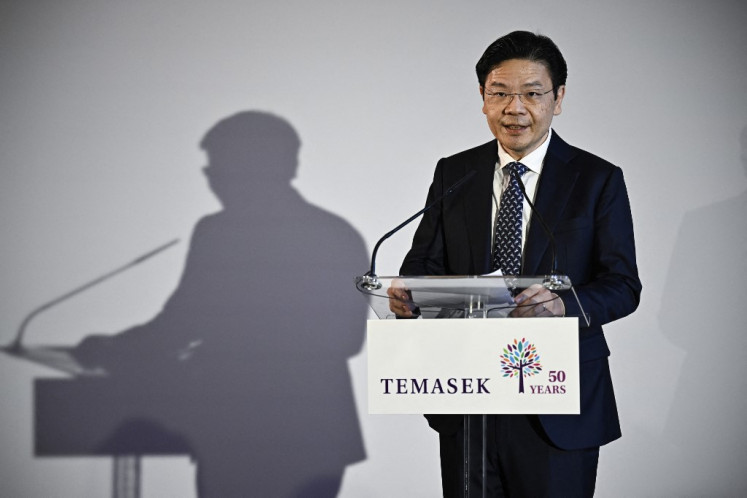Preserving heirlooms in Kerinci
Tradition: Men clean the kris and sword heirlooms of Datuk Kederuk Ilealamea that are believed to date back to the period of the Pagaruyung Kingdom
Change Size

T
span class="inline inline-none">Tradition: Men clean the kris and sword heirlooms of Datuk Kederuk Ilealamea that are believed to date back to the period of the Pagaruyung Kingdom.
The home of Saukani, 68, in Baru hamlet in Sungai Penuh, Jambi, was crowded with relatives and friends the day after Idul Adha (Islamic Day of Sacrifice), with at least 60 people present to observe ancestral heirlooms washed in a traditional ritual.
The heirloom-washing ritual, ngisai padanden, was held in the semi-permanent home of a descendant of Datuk Kederuk Ilealamea in Baru, where Saukani is now the datuk (local honorific title for an elder). Each succeeding datuk inherits the two-story traditional structure.
“This tradition is observed no less than once a year and this time it’s been two years since the last ritual. The post-Idul Adha date was chosen as many family members usually return home then,” said one of the visitors, Feriyanto, 39.
Female attendees each brought along three portions of cooked rice in banana-leaf wrappings called nasi ibat and beef curry soup, food typical of Kerinci, a regency in Jambi to which Sungai Penuh belonged before its split.
They also contributed a dipper of rice grains and between Rp 1,000 (10 US cents) to Rp 5,000 as required by the ceremony. The rice and money gathered was meant as an “honorarium” for the pawang or ritual master.
With the food laid down on mats and everybody sitting, a prayer was offered before everyone dined together, followed by another prayer for God’s consent to ensure the smooth performance of the ritual.
The ritual began with the presentation of offerings comprising spiced yellow rice, rice mixed with bananas on split bamboo joints, curried beef, rice in cups with eggs and various flowers.
Three containers had been prepared with solutions of water and the juice of three kinds
of citrus fruit to wash the heirlooms. The ritual master, Depati Jufri, 57, also a communal leader in neighboring Nek hamlet, conducted the ceremony.
He began by burning incense and saying mantras in the local Kerinci language, speaking to the spirits of the ancestors who possessed the heirlooms and the guards protecting the treasures. He then went upstairs with several elders to bring down three dusty wooden boxes and placed them near the offerings.
After yet another prayer, the master opened the first box, taking out an old, short glass bottle with the words: “Catilina’s, Best Worm Tablets, prepared: by Weggmeister & Retzogert”. The bottle contained 20 precious stones of different colors in coconut oil.
“Two years ago when they were washed, only 18 were left. Now they’re back again,” said Saukani. According to the man, the valuables can disappear unless they are regularly washed in the ritual.
The stones were put back into the bottle after being washed with new coconut oil, while the used oil was offered to visitors as it is considered effective to heal various complaints if rubbed on the affected area. There was also a tuft of hair to wash, believed to have come from the head of Datuk Kederuk Ilealamea as a youth.
The second box held a very old book in Arabic characters wrapped in white fabric. The book was in
tatters so it could only be dusted through the outer cloth. Aside from that there was a ceramic bowl with the words “Made in Holland” at the bottom.
The third, longer box preserved several weapons. A straight kris in a blue sheath with carvings
and a golden tip and two other long swords. After being cleaned, another prayer concluded the ceremony and the boxes were then returned upstairs. 
Guests flocked to obtain the used citrus water, each getting a plastic container to take home. “At home, we’ve got to take a bath with this water so that our forebears won’t “call” us. If they do, we can get sick,” said Martinah, 60, who had also taken a bit of the used oil.
Depati Jufri has been a pawang for Kerinci heirloom-washing rituals since he was 12. Learning the skill from his father, he said he was only an intermediary that could make contact with the spirits of their ancestors.
“I can feel their presence, and only then can we clean the heirlooms. Unless they are cleaned, the succeeding generations won’t live peacefully,” said the man who makes his living as a farmer.
As a ritual master, he serves all the Kerinci ethnic groups, washing the heirlooms of the other ancestors like Datuk Kederuk Putih and Datuk Kederuk Hitam. He used to have several peers, but now only two are left. “Scorning heirlooms is a taboo in this ritual. Whoever does will be cursed with illness,” he warned.
Saukani said Datuk Kederuk Ilealamea had lived long before the Dutch colonizers came to Kerinci in 1903, and been known as a man with supernatural powers capable of disappearing in the yard of his home. He was therefore given the name “Ilealamea” (gone in the yard). His grave has not yet been found.
“The kris came from Java through Pagaruyung [West Sumatra] and all the weapons had been used by his followers in the struggle against the Dutch,” he said. The datuk had three wives so this is the heirloom house of the descendant of one of the three.
“The heirlooms can’t be moved to other houses and should always be kept upstairs. They should actually be in the house of a female descendant but as there’s no one, I have to take over the responsibility,” he said. He said he has no fear of theft because, “Anybody stealing the
treasures will fall ill.”
After the boxes were stored, an Asek dance was performed by a group of women followed by a group of men, where people danced round somebody older than themselves. Once in awhile, a dancer would become possessed by an ancestor’s spirit, but on this occasion that did not occur.
The tradition of maintaining heirlooms as sacred property has saved many historic Kerinci items. Some of the objects are only washed every 10 or 20 years and nobody is allowed to take any of them away. Dozens of heirloom houses still exist in Sungai Penuh city and throughout Kerinci regency, places that keep not only weapons but also manuscripts, buffalo horns and bamboo pieces.
A manuscript believed to be from the era of Adityawarman when he reigned over Dharmasraya, upstream of Batang Hari before establishing the Pagaruyung Kingdom in Tanah Datar, West Sumatra, is one of those documents. Written on daluang (bark), the text is estimated to date to the 14th century.
Uli Kozok, a German philologist, has studied the manuscript that had been storied in a home in Tanjung Tanah on the banks of Lake Kerinci. He has described the text, written in Malay, as the oldest Malay document in the world.
Known as the Tanjung Tanah Law, the manuscript reveals no trace of Muslim practices in the area, belying the previous belief that Malay texts only appeared after the beginning of the Islamic period in Kerinci.
— Photos By JP/Syofiardi Bachyul Jb









